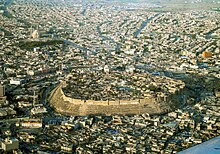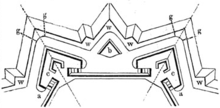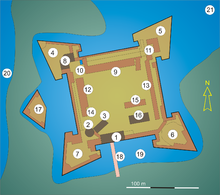citadel
A citadel is a small, self-contained fortress that either lies within a larger one or forms part of the enceinte (i.e. the main fortification line) of the larger fortress. When the city was stormed by enemy troops, it served as a retreat for the garrison and the city's last core of resistance. The name was borrowed from the Italian cittadella in the early modern period , which means "small town".
location
A citadel is positioned either inside or on the edge of a city fortification . Often it was deliberately built in the center of a city that was viewed as disloyal and thus served a purpose similar to the medieval fortress . With its location outside the city, the esplanade separates the citadel from the other fortifications as a free field of fire and retreat.
Free outer shape

The oldest form of the citadel is the fortress located on a hill within or on the edge of a city. The external shape of these citadels was derived more or less directly from the outline of the mountain or hill on which they stood. In ancient Greece they were called the Acropolis , which means "high city". They also fulfilled the function of a sanctuary.
Later examples, such as the Petersberg Citadel in Erfurt or the Bitsch Citadel, were based in their rough overall shape on the height profile of the landscape or the outline of a mountain.
Examples
within Germany
- Erfurt - Petersberg Citadel
- Münster - Citadel of Münster
- Vechta - Citadel Vechta
- Wesel - Citadel Wesel
outside of Germany
- Aleppo - Citadel of Aleppo
- Athens - Acropolis (Athens)
- Bitche - Citadel of Bitsch
- Budapest - Citadel (Budapest)
- Erbil - Citadel of Erbil
- Ephesus / Selçuk - Citadel of Selçuk
Regular polygon
At the beginning / middle of the 16th century, a new form of citadel was developed on the basis of the bastionary system, which had the floor plan of a regular polygon or star (see the sections "Origins of the bastionary system" and "Development of the New Italian manner" in the article History of the modern fortress ). In the 17th century, the French Marshal Sébastien Le Prestre de Vauban refined this principle very successfully. As a result, citadels in some regions are also commonly referred to as " Vauban fortresses ". Due to the ingenious geometry of the fortifications, it was less dependent on the protection that an elevated position on a mountain would bring. Therefore, many Vauban fortresses can be found in rather flatter regions (→ Niederungsburg ), where, in contrast to the mountain location (→ Höhenburg ), it is easier to create a system of protective moats.
However, the “geometric ideal” of a regular star with the bastions as jagged points could only be implemented in its purity with completely new fortresses on the plain. In the case of mere modernization of fortresses or in hilly terrain, the fortifications had to be adapted to the local conditions (see, for example, the Citadel of Bitsch in the above section). Or the shape of the citadel was more based on the fortification system of the city; the Wesel citadel might be an example (see also the section above).
Examples


within Germany
- Berlin - Spandau Citadel
- Jülich - Citadel Jülich
- Magdeburg - Citadel Magdeburg
- Mainz - Citadel Mainz
outside of Germany
- Antwerp - Citadel of Antwerp
- Jaca - Citadel of Jaca
- Landskrona - Landskrona Citadel
- Lille - Citadel of Lille
- Pamplona - Pamplona Citadel
- Strasbourg - Citadel of Strasbourg
- Turin - Citadel of Turin
See also
- Fortification buildings in Königsberg
- Tell (archeology)
- Alcázar (castle)
- List of technical terms in fortress construction
literature
- Hans-Rudolf Neumann (arrangement): Preservation and use of historical citadels. Philipp von Zabern, Mainz 2002, ISBN 3-8053-2987-3 .
Web links
Individual evidence
- ↑ Bernhard von Poten (Ed.): Concise dictionary of the entire military sciences. Volume 2: Bergen to Döbeln. Velhagen & Klasing, Bielfeld u. a. 1877, sv “Citadellen”.
- ↑ Erbil Citadel - UNESCO World Heritage Center , whc.unesco.org. Retrieved January 28, 2015

